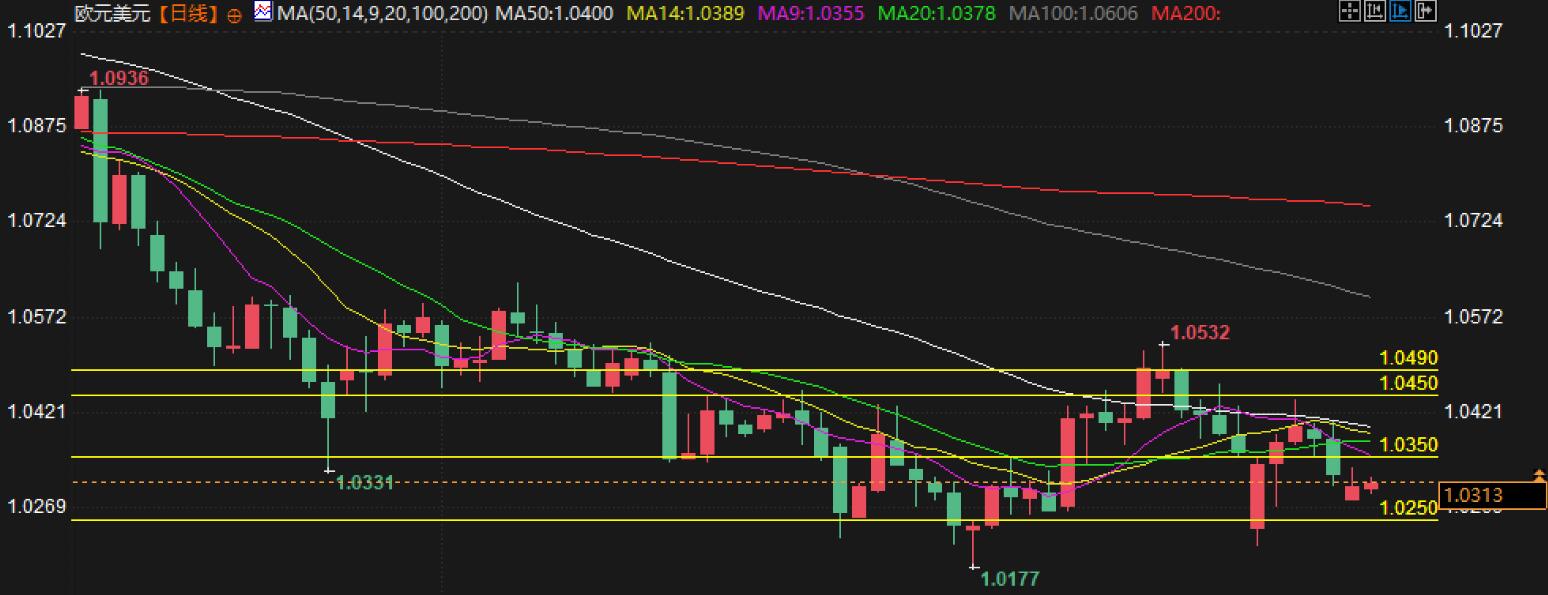EUR/USD trading analysis: Can it break through 1.035?
On Tuesday (February 11th) during the European trading session, the EUR/USD is currently trading at 1.0315. The overall performance of the euro in the current market is weak, with a short-term fluctuation range of 1.0250 to 1.0450. Fundamental and technical analysis indicates that the risk of breaking through key support levels is low, and future trends will continue to be influenced by economic data and policy changes.
Fundamental analysis
Recently, the performance of the Euro (EUR) has been relatively weak, and the impact of market sentiment and changes in economic data have put varying degrees of pressure on the trend of the Euro. According to the analysis of UOB Group's foreign exchange analysts, the downward pressure on the euro is relatively obvious, but the current trend does not seem to have a strong risk of breaking through the important support level of 1.0250 in the short term, especially the possibility of breaking through it is relatively small. From a fundamental perspective, the current economic outlook for the Eurozone is relatively complex, with factors affecting the trend of the Euro including internal economic growth, inflationary pressures, and changes in global risk appetite.
Although some economic data in the eurozone show signs of recovery, overall economic growth remains sluggish, especially in some major economies such as Germany and France, where the trend of slowing growth is more pronounced. In addition, there is also a certain degree of uncertainty in the monetary policy of the European Central Bank. Despite the European Central Bank's interest rate hike policy in response to inflation in the past few years, the current rate hike cycle may be coming to an end, leading to divergent views on the long-term prospects of the euro in the market. Overall, the fundamental outlook for the euro remains weak in the short term, but due to the lack of strong driving force for further decline, the risk of the euro falling below the main support level is relatively limited.
The changing risk appetite in the global market is also an important factor affecting the euro. Recently, due to the strong economic growth performance of the United States and the still hawkish policy outlook of the Federal Reserve, the relative strength of the US dollar has put significant pressure on the euro. At the same time, changes in global risk sentiment have directly affected the performance of the euro. Against the backdrop of the impact of US tariffs, changes in market risk aversion may have an impact on the euro, thereby affecting its exchange rate fluctuations.
Technical analyst interpretation:
From a technical perspective, the price trend of EUR/USD is currently in a complex range of fluctuations, with a relatively stable overall trend in the short term and weak market sentiment. UOB's analysis suggests that the euro may continue to consolidate downwards, but the probability of falling below the important support level of 1.0250 in the short term is low. From the current price trend, the daily chart of EUR/USD shows some downward pressure, especially in the resistance range around 1.0350. The price has repeatedly failed to effectively break through this level, indicating heavy selling pressure in the market.

According to UOB's analysis, the recent price fluctuations are relatively limited, and it is expected that the euro/dollar will fluctuate and consolidate within the range of 1.0250 to 1.0450. From the short-term technical trend, there is some selling pressure above the 1.0350 level, and the euro may encounter resistance again. On the downside side, 1.0275 and 1.0250 are two key support levels. If the price falls below 1.0250, it may trigger further decline, but considering the current market situation, the possibility of this drop is relatively low.
From a longer-term perspective, the trend of the euro/dollar still exhibits a range oscillation characteristic. In the past few weeks, prices have fluctuated within the range of 1.0250 to 1.0490, indicating a lack of clear direction in the market within this range. The current technical situation still suggests that the euro/dollar will consolidate within a relatively small range of 1.0250 to 1.0450, and the market still lacks clear trend signals.
Future prospects
Overall, the trend of the euro may continue to fluctuate and consolidate within the current range, and downward pressure still exists in the short term, but the possibility of breaking through the important support level of 1.0250 is relatively small. Technical and fundamental analysis suggests that the price volatility of the euro may be limited in the coming weeks, and market sentiment remains relatively cautious. If the price can break through the resistance level of 1.0350, it may trigger a new upward trend.
Overall, the short-term trend of EUR/USD is still influenced by multiple factors. Within the range of 1.0250 to 1.0450, the euro is likely to maintain a volatile consolidation unless there are new economic data or policy changes that drive a clear directional breakthrough in the euro.
Tips:This page came from Internet, which is not standing for FXCUE opinions of this website.
Statement:Contact us if the content violates the law or your rights
